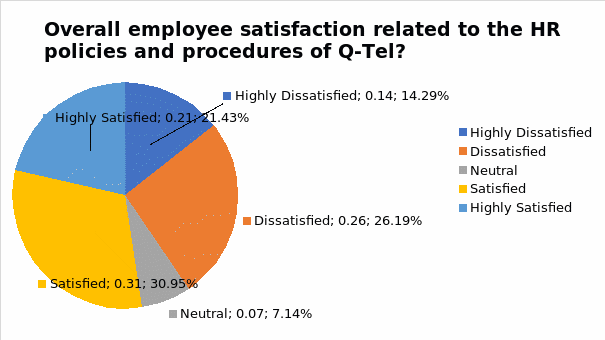Abstract
Managing employer-employee relationship has remained a challenging task for companies. With changing dynamics of businesses and emphasis on acquiring intellectual property as a source of survival companies rely heavily upon their employees to generate new ideas that could help businesses not only to sustain but also flourish. Competitive market conditions are always exerting pressures on business to maintain an efficient and effective human resource framework and ensure employee involvement in decisions related to them. These competitive forces operate as a pull factor that could convince employees to leave their current employer and move to other organizations that are offering better working conditions as perceived by them. Preventing or mitigating employee turnover is increasingly becoming a daunting task for the corporate sector.
The current study examines different elements of HRM policies and procedures using a case study of Qatar Telecom Q.S.C. The research incorporates both primary and secondary research to derive important conclusions regarding employees’ perceptions of the company’s HR policies and procedures and how these affect their motivation and job satisfaction. The results imply that employees of the company are presently not satisfied with the way issues related to HR are managed by the company. Finally, recommendations are suggested for the company to improve employees’ participation and performance thus leading to higher motivation and job satisfaction.
Disclaimer
The researcher hereby claims that the study has been conducted according to the guidelines provided by the university. Report writing has been ensured to be free of issues of plagiarism and copyright. Credentials have been fully recognised and provided as a part of the report. Furthermore, the conduct of primary survey has been carried out after permission had been sought from the department and all ethical considerations were permitted. Moreover, it is also claimed that although all due efforts are made by the researcher to ensure the objectivity and integrity of different sections of the report no business decisions must be placed upon findings presented in the report. Finally, no permission for reprinting or publishing of the report without the consent of the researcher and his instructor is granted.
Introduction
Background to Context
Managing employer-employee relationship has remained a challenging task for companies. With changing dynamics of businesses and emphasis on acquiring intellectual property as a source of survival companies rely heavily upon their employees to generate new ideas that could help businesses not only to sustain but also flourish. Competitive market conditions are always exerting pressures on business to maintain an efficient and effective human resource framework and ensure employee involvement in decisions related to them. These competitive forces operate as a pull factor that could convince employees to leave their current employer and move to other organizations that are offering better working conditions as perceived by them. Preventing or mitigating employee turnover is increasingly becoming a daunting task for the corporate sector.
Therefore, it could be suggested that human resource is one of the most valuable asset for businesses and managing it could be considered as a difficult task. Literature on management of human resource entails different theories that have been integrated in different human resource strategies tested out and implemented by companies across the globe. Most of the studies have evolved from practices in developed economies and existing literature lacks in-depth supporting information related to HR practices in the developing economies. The present study attempts to fill this gap by investigating HR policies and procedures of one of a major corporation operating in the telecommunication industry that is highly competitive industry and companies are continuously seeking new ideas and talent not just locally but also from international markets.
Qatar Telecom Company Profile
Qatar Telecom (Q-Tel) Q.S.C. is the exclusive telecommunication services company operating in Qatar that offers a wide range of telecommunications services in Qatar (AME Info 2010). The company was established in the year 1987 as Qatar Public Telecommunications Corporation (Bloomberg 2010). However, in November 1998 the company changed its name to present Qatar Telecom (Q-Tel) Q.S.C. upon enlisting of its stocks on Doha Securities Market (DSM). The company is operating in 17 countries serving to millions of customers in the Middle East, North Africa and South East Asia. The company is also listed on London Stock Exchange, Bahrain and Abu Dhabi Stock Markets (AME Info 2010).
The company’s human resource department is led by Mr. Saud Bin Nasser Al Thani who is the Executive Director of Group HR and Executive Director of General Services (Bloomberg 2010). The company presently employs more than 2,000 employees in its network of operations (AME Info 2010).
Objectives
The objectives set out for the current dissertation are:
- Analyzing and evaluating the main HRM elements of Q-Tel in respect to the HRM theories.
- Assessing the impact of HRM policies and procedures on employees’ performance, motivation and satisfaction.
- Proposing recommendations / solutions to be considered by the organization.
Project Aim
The research is aimed at acquiring employees’ perspectives of the HR policies and procedures related to four major functions of HRM in Q-Tel. The HRM elements that are analyzed in this study are:
- Employees resourcing (recruiting and selection methods).
- Equal treatment at work and managing diversity.
- Rewards types and implementation methods, and paying for performance method.
- Retention of employees and some aspect of HRM during financial crisis.
By addressing issues and views of employees working for the company the current research sets out conclusions regarding the HR practices of the company whether they actually contribute to better performance, motivation and satisfaction for employees.
Significance of Research
The research carried out in this report holds a substantial value as it provides study of HRM at one of the largest companies in Qatar. The study provides a thorough insight into the HR policies and practices of the company that would help the users of this report to generalize the trends of HRM in Qatar. The users of the current report could also assess whether the HR policies and practices of Q-Tel are comparable to the global standards and they in fact contribute to higher levels of performance quality, motivation and satisfaction for employees working in the telecommunication sector of Qatar.
Research Hypothesis
The study carried out in this report is based on a contemporary analysis of HR policies and practices of Q-Tel and its impact on employees and the analysis establishes whether the following research hypotheses set out for the study are accepted or rejected:
- the HRM policies and practices implemented by Q-Tel are positively contributing to employees’ performance, motivation and satisfaction.
This hypothesis is tested out in this report through analysing employees’ responses to different elements of human resources policies and procedures implemented by the company under review that would assist in developing an opinion on the company’s HR policies related to recruitment and selection, diversity, promotion and rewards and retention.
- the HRM policies and practices implemented by Q-Tel are not comparable to the global standards and are negatively contributing to employees’ performance, motivation and satisfaction.
This hypothesis is similarly tested out in the report by evaluating the responses of employees working in the organization.
Research Questions
The study aims to provide carry out an investigative research to find suitable answers for the following research questions:
- What are the organizational policies and procedures related to various elements of HRM?
- What effects HRM policies and procedures have on the employees’ performance, motivation and satisfaction?
- How did the HR department manage employee relationships during difficult time of the recent global financial crisis?
- What can the company under review do to improve its HRM?
Scope
The scope of the study is limited to the research methodology adopted for this purpose. These limitations are discussed in the later chapter. However, it is further stated that the above set research questions are not exhaustive and a different approach and research parameters could result in different findings as compared to the ones presented in this report. Furthermore, the outcome of the research is dependent on the researcher’s own ability and knowledge of the subject.
Literature Review
Introduction
This chapter provides a theoretical framework for the present study entailing important definitions and theories related to motivation and job satisfaction. Different intrinsic and extrinsic factors are explained in this section of the report that form the basis of the study and consequent analysis of the impact of HR policies on employees’ motivation, satisfaction and performance. Moreover, this chapter also provides useful previous studies that are majorly carried out with an outlook of companies operating in developing economies.
Motivation
There have been numerous explanations for understanding human psychology and factors contributing to individual’s motivation yet it is very difficult to give a concise definition of motivation and several authors have defined it in their own way. Motivation is a term that is derived from a Latin verb ‘movere’ meaning ‘to move’ (Pintrich and Schunk 2002). Taking it further the term motivation is driven from another word ‘motive’ that refers to a state of mind that “moves or activates or energies and directs our behaviour towards out goals” (Kumar 2008). Motivation is therefore viewed as “the process whereby goal directed activity is instigated and sustained” (Pintrich and Schunk 2002). It allows an individual to take a course of action that could direct their efforts to achieve specific goals and objectives (Kumar 2008). Robert Dubin (1958) defines motivation as “something that moves the person to action and continues him in the course of action already initiated”. Another definition of motivation by Zaphiris and Ang (Zaphiris and Ang 2009) states that “a motivation is a willingness or desire triggered by an emotion or external stimulus to pursue a goal or a reason for triggering an action” (p. 688).
Motivation Hypotheses
The concept of motivation can be further examined by developing an understanding of four underlying hypotheses as suggested by (Skehan 1989).
Intrinsic eagerness to accomplish work and the drive to accomplish work is the best definition to describe an employee’s motivation. Every employee or any individual is motivated about something or the other in their lives. Combining the fulfillment of needs and desires of employees in the workplace is what enables employee motivation. Accounting for these variables can be a challenging task. Motivation, in order to be understood, can be broken down into four assumptions. These assumptions are proposed by Skehan (1989). These assumptions help in clarifying the true sense of the definition of the term motivation. These assumptions are:
- Intrinsic – reveals the internal interest of people.
- Resultative – reveals motivation as a resultant of a probable action.
- Internal Cause – reveals that motivation is seen as a resultant particular learning.
- Extrinsic – reveals that motivation is the resultant of exterior (Skehan 1989).
Therefore, motivation can be an outcome of any cognitive behaviour that individuals display (Zaphiris and Ang 2009).
Motivation Theories
Content Theories
Content theories describe the precise factors that stimulate people. They explain what drives individual performance.
McGregor’s Theory X and Theory Y
Douglas McGregor anticipated two diverse motivational theories. Managers are inclined to utilize any one of the two on their employees as per the requirement. Theory X states that employees have an aversion to and try to keep away from work, and must be forced to do work. Most workers are short of aspiration and look forward to job security more than anything else (Hackman and Oldham 1976).
McGregor in person held that the more hopeful and positive theory, Y, was more suitable. This theory embraces that employees can vision work as ordinary, are original, can be vibrant, and be grateful for accountability. This type of philosophy is well-liked now, with self-empowered work teams turning out to be a norm (Hackman and Oldham 1976).
Maslow’s Hierarchy of Needs
The cornerstone of Maslow’s motivation idea is that human beings are inspired by discontented desires, and that convinced inferior factors require to be persuaded before higher desires can be content. According to Maslow, there are general kinds of desires namely “physiological, survival, security, love, and esteem” (Heilmann 2008) that individuals must attain before they can proceed unselfishly. He called these desires “deficiency needs”(Heilmann 2008). As long as we are inspired to persuade these cravings, we are going in the direction of development, in the direction of self-actualization. Satisfying desires is wholesome, while stopping fulfillment makes us ill or proceeds evilly (Heilmann 2008).
Herzberg’s Motivation-Hygiene Theory
Herzberg sensed that job approval and dissatisfaction live on dual scales. Definite things, called ‘hygiene factors,’ could origin an individual to become sad with their work. These things, encompassing yield, job security, and personal work natural environment, could not ever convey about job contentment. Motivating components, on the other hand, can boost job satisfaction. Giving workers things for example a sense of acknowledgement, blame, or accomplishment can convey satisfaction (Herzberg, et al. 1957).
Process Theories
The following theories are helpful in understanding motivation, particularly for managers and business students.
Locke’s Goal-Setting Theory of Motivation
Goals or aims motivates employees to rendezvous higher presentation levels. Employees are more probable to attain accessible goals, but permitting them to become involved in goal setting can boost their motivation towards working for the firm’s benefit and attain even the those goals that are toughest to achieve (Porter, Bigley and Steers 2002).
Skinner’s Reinforcement Theory of Motivation
Reinforcement idea is a behaviorist submission founded on the concept that persons are not propelled by motivation, but by their surroundings. The reinforcers, or affirmative penalties, are what make a performance more probable to be custom than exemption (Skinner 1953).
Reinforcers work most excellent when they are direct, genuine, and exact to an action. Managers who like to request reinforcement idea into a place of work can manage so through managerial demeanor alteration, a thriving and technical set about to altering demeanor founded on the study of B.F. Skinner.
Job Satisfaction
Satisfaction of employee retaining them has habitually been significant matters for managers. After all, high grades of absenteeism and employees revenue can sway your base line, as temps, staffing and retraining are heavily levied (Hackman and Oldham 1976). But a lot of practices have made work approval a huge concern, probably because they have botched to realize the important opening that lies in facade of them. Satisfied workers are inclined to be more creative, creative and pledged to their employers, and latest investigations have shown a direct association between employee’s retention and persevering satisfaction.
In the late 1950s, Frederick Herzberg who is considered to be one of the pioneers in motivation theory conducted a study aimed at determining what factors contribute to their satisfaction and dissatisfaction. In his research he interviewed a group of employees and inquired of them fundamentally two sets of questions:
- “Think of a time when you felt especially good about your job. Why did you feel that way?
- Think of a time when you felt especially bad about your job. Why did you feel that way?” (Hackman and Oldham 1976)
Results of these interviews helped in developing his theory that there are two scopes of job satisfaction: motivation and hygiene.
Hygiene issues, are not motivators but are a good source of minimizing displeasure, if handled correctly. Therefore, it could be suggested that hygiene factors can lead to dissatisfaction if not provided satisfactorily. Hygiene factors include “company policies, supervision, salary, interpersonal relations and working conditions” (Hackman and Oldham 1976). They are usually linked to the worker’s surrounding. Motivators can make satisfaction by satisfying individuals’ needs for sensible and individual growth. These issues include “achievement, recognition, the work itself, responsibility and advancement” (Hackman and Oldham 1976). Once the hygiene areas are dealt with, the motivators will endorse job satisfaction and hearten production (Hackman and Oldham 1976).
Managers can create work environments that magnetize, inspire and preserve hard-working employees and will be in a better position to do well in spirited and healthy surroundings that demand excellence and efficient cost levels. Moreover, creating a healthy workplace for their employees may even help in augmenting their own job satisfaction level.
Previous Studies
It is significant to note that the literature on job motivation and productivity was neither decisive nor consistent (Chew 2005). However, research going out with times back to Herzberg have shown high association among high self-confidence and high efficiency, and it does appear correct that more persuaded employees will be inclined to add more worth to an organization. Unhappy workers, who are inspired only by a worry of losing the job, will not give 100 per cent of their efforts for a long time span. Though worry is a powerful motivator, it is furthermore a provisional one, and when the risk is hoisted off presentation will turn down. Owing to such causes, the advocate to enquire the grade of job consent and its consequences has been of concern to associations and researchers since long (Chew 2005).
Hawthorne and others undertook the behavioral discipline of thoughts and overemphasized the meaning of job approval for the managerial achievement and worried that the need of approval can demonstrate the way to grave penalties. Among such penalties, one is the purpose of returns, which can guide to the next, the occurrence of real returns activity. Insinuation of revenue aim may have domino result on other human asset anxieties encompassing value of service, productivity and finally general organizational success. Further to these consequences it may furthermore lead to cover costs on recruitment and teaching of the new replacement, in addition to its contradictory result on service consignment and efficiency. Hence, Job approval shows as to how content an employee is with his or her job (Weisberg and Kirschenbaum 1993).
Other controls may comprise; “the management style and culture, employee involvement, empowerment, job rotation, job enlargement and job enrichment and autonomous work groups etc” (Skinner 1953). Because job satisfaction and return are significant factors in managerial efficiency, therefore, the subject has always been the center point of organizational leaders and researchers, as they want to learn more about the elements of job satisfaction and aim to profit and their impending association (Porter and Steers 1973). One of the reasons that induce the managers to be concerned about the job satisfaction of their under authority employees as resolute by a variety of researches, that it can be utilized to foresee job separations, renouncements and labor efficiency. Job satisfaction is a topic of substantial attention to companies since it is probable to sway a worker, and therefore the firm’s, performance (Weiss 2002). Efficiency and profitability are probable to be advanced if workers have an elevated altitude of job satisfaction. Job turnover is also probable to be higher in firms that have a low level of satisfaction at work, thus resulting in advanced training costs. It is also significant for personnel to be happy in their work, given the quantity of time they have to dedicate to it all the way through their operational lives (Heilmann 2008).
Commitment to organizational firms has been a well liked area of study amidst organizational and demeanor investigators since the 1960s with Becker’s work. Becker concludes that “commitments arrive into being when an individual, by producing a side-bet, connections extraneous concerns with a reliable line of activity” (Miller 1980) and, farther, “that individual bonds to the association are founded on ‘instrumental interests’ for example wages and benefits”. From that issue, concern in the occurrence expanded” (Porter, Bigley and Steers 2002). For expression, Cotton and Tuttle (1986) reports that, “there has been an extended concern in the commitment of workers to their organizations”. This is because organizational commitment is “identified as one of the foremost determinants of organizational effectiveness” (Porter, Bigley and Steers 2002). Thorndike (1911) add that “organizational firm promise is evolving a progressively utilized assemble to forecast presentation, absenteeism and turnover” (Thorndike 1911).
Krau (1981) further go on to mention that current management styles are developing out to be refining the connection among the augmented executive commitments and superior levels of work performance, low degree of absenteeism and inferior heights of employee turnover. Heilmann (2008) suggest that “organizations of all sizes and types are recognizing that they are engaged in a struggle to retain talent, and are actively trying to do something about it” (Heilmann 2008).
Employee Motivation, Satisfaction and Performance are linked to Salary and Compensation
The literature reconsidered for the purpose of this paper was farther investigated to supply considerable outcome although there were important dissimilarities over the study from distinct Arabian countries. Moreover, the learning outcomes illustrate that, while an appealing bundle of take home package is productive in patenting job motivation; balancing planned human assets practices are deeply significant in decreasing employees’ turnover (Ali 1990). These outcomes are considered in periods of the other compliance facets of well-integrated human asset practices. Other investigations that moreover pointed out the implication of salary and compensation in enhancing job motivation include Lakhani’s “The Effect of Pay and Retention Bonuses on Quit Rates in the US Army” that proved negative relation between pay level and motivation to perform (Lakhani 1988).
Koh and Goh, in their case study on Qatar: an analysis of the factors affecting the turnover intention of non-managerial clerical staff proves that job satisfaction coupled with monetary rewards is negatively associated with employee turnover or de-motivation (Koh and Goh 1995). Krau in his paper on Qatar “Turnover analysis and prediction from a career developmental point of view” argues that there is affirmative relation between benefits and job satisfaction (Krau 1981).
According to several researchers, monetary compensation and job satisfaction are positively associated with each other. Souza-Poza identified in Egypt that and employees pay is an interpreter of his satisfaction at workplace and a reason for enhanced performance (Sousa-Poza 2000). Joanne Miller established that workers who were compensated greatly demonstrated enhanced job satisfaction and were more motivated with others to perform well (Miller 1980).
HR Policies and procedures and their impact on Employee Motivation, Satisfaction and Performance
Supervision and Job Satisfaction
Many researchers have established an affirmative connection between job contentment and supervision. Billingsley and Cross (1992) retains that displeasure with management or supervision directs to job dissatisfaction. According to Ting workers seem to be more content with their job if their supervisors assist and co-operate with them in accomplishing their daily tasks. If this connection is good, sub-ordinate will be persuaded with his general job else he won’t be (Ting 1997).
Promotion and Job Satisfaction
The connection among advancement and job satisfaction is affirmative as asserted by numerous researchers. Tutuncu and Kozak’s study of a hotel in Bahrain recognized that components that lead to job satisfaction include the job description, supervision and promotion (Tutuncu and Kozak 2006).
Working Conditions and Job Satisfaction
Job content, situation of workplace and surroundings were recognized as key components that could boost job satisfaction and performance (Chew 2005).
Coworkers Integration and Job Satisfaction
DeVaney and Chen discovered that co-worker association was a powerful determinant of job satisfaction and motivation at work (DeVaney and Chen 2003).
Social Status and Job Satisfaction
According to numerous researches, communal rank and job approval are associated to each other. According to Wong Ting Hong educators displayed a mean point of 0.158 satisfactions with status in society. It displays that educators are not persuaded with communal position (Ting 1997).
Gender and Turnover
According to Cotton and Tuttle, feminine employees are more probable to leave their jobs unsatisfied than male workers (Cotton and Tuttle 1986). Few other investigators like Weisberg and Kirschenbaum strengthen the Cotton and Tuttle outcome when they discovered that the identical connection between gender and turnover as Cotton and Tuttle did. It is suggested that female workers are more sensitive to their environments and financial security (Weisberg and Kirschenbaum 1993).
Diversity at Workplace
Managing diversity in workplace is increasingly becoming challenging for firms to manage. Achieving diversity at workplace is “a process of systematic organizational change” (Hubbard 2004, p. 326). Valuing differences and maintaining a balance between these values shared between individuals with diverse ethnic, cultural, professional and religious backgrounds has become an integrated element of HR policies implemented by companies (Jackson 1992).
Conclusion
The above literature review provides both theoretical framework and empirical data to support the objectives of the present study that focuses on four major elements of HRM including recruitment, promotion, diversity at workplace and retention. In particular, the research is carried out in the context of theories including Maslow’s Hierarchy of Needs, Herzberg Motivation-Hygiene Theory and Locke’s Goal-Setting Theory of Motivation that have helped the study to focus on specific areas of HRM.
Research Methodology
Introduction
Developing a comprehensive research methodology is crucial for achieving the research objectives. In fact the outcome of the study is dependent upon the approach used for collecting its data (Saunders et al. 2007). This chapter outlines the research methodology and approach that have been adopted for the present study.
Adopted Research Methodology
The selected research methodology for the current study is of qualitative nature that is based on phenomenological paradigm. This approach provides a descriptive analysis of findings collected from both primary and secondary sources. The analysis would results in conclusions and recommendations based on the researcher’s own interpretative skills and knowledge of the subject and no statistical model has been used. The research approach is deductive that involves examination of behaviours and patterns of a larger group and then results are derived for application to a smaller group (Taylor, Gautam and Ghoshal 2006)

Data Collection
Primary Data
Primary data comprises of the responses of employees working for Q-Tel related to their views on the HR policies and procedures practiced within the organization. The research strategy selected for this purpose is survey research (Saunders et al 2007)
Survey Questionnaire
Designing and developing survey questionnaire has been the most vital step of the study. The reason for selecting questionnaire instead of other data collection techniques such as interview and focus group etc. is because of its ability to inquire a large number of questions and target a larger sample population. Survey questions are based on Likert scale method that allows responses to be measured as “a degree of agreement or disagreement with each of a series of statements” (Malhotra 2009, p.274).
The questionnaire has been drafted in such a way that it covers four major elements of HRM in Q-Tel. These include recruitment and selection, approach to diversity, promotion and rewards, and retention. Each element has been addressed by a series of simple statements and questions that are aimed at covering different aspects of HRM and how these are perceived by employees working for Q-Tel. Under each element of HRM a question is included that assess overall sentiment of employees’ HR policies related to that particular element. Responses are ranked from 1 to 5 for each statement or question. Scoring is in such way that 1 implies ‘Strongly Disagree’ and 5 implies ‘Strong Agree’ whereas 2 and 4 imply ‘disagree’ or ‘agree’ views by respondents. Additionally, overall assessment of four elements of HRM are based on scoring such that 1 implies ‘Highly Dissatisfied’ and 5 implies ‘Highly Satisfied ’ whereas 2 and 4 imply ‘dissatisfied’ or ‘satisfied’ views by respondents. Moreover, value of 3 reflects a neutral view that implies that employees do not have a definite opinion or lack information regarding the question or statement. Finally, the questionnaire concludes with a question that determines the overall job satisfaction of employees.
Sampling
For the purpose of collecting Q-Tel’s employees’ views and opinion regarding different elements of HR policies and procedures the survey questionnaire has been conducted within the organization. The selection of sample of respondents has been random without distinguishing between respondents on the basis of job description, years of experience, gender, etc. This approach has been used to keep the identity of individuals unrevealed and remove a degree of biasness that may affect the outcome of findings from the survey questionnaire. However, this surely has some impact on the analysis of such findings as certain questions may have required additional information to support the opinion formed in this report.
The survey was conducted at ADDRESS office of Q-Tel that employs 2500 employees. From these 120 employees were randomly selected that is 6% of the entire work force and the questionnaire was sent to them via email.
Secondary Data
Various sources have been thoroughly examined and referred to in this report. The secondary data has been used for forming detailed literature review, research methodology and to support the findings from the primary research. Corporate literature has been acquired from the company to encapsulate HR policies implemented by the company.
Basis for Analysis
For data analysing and developing important conclusions from the research averages are calculated for each statement and question inquired from the respondent under each element of HRM. If average response values are more than three than this implies that the company’s HR policies are perceived to have positive impact on employees’ motivation and performance. If average response values are less than three than the company’s HR policies are perceived to have negative impact on employees’ motivation and performance. This analysis is also supported by tables and graphs for better readability and understanding by the users.
Limitations
There are certain limitations pertaining to the research methodology selected for carrying out the present study:
- The approach used for the research is qualitative that is descriptive in nature and dependent upon researcher’s own interpretative skills that makes the outcome of the research rather subjective. The use of quantitative approach using statistical model could have resulted in better indication of correlation between different elements of HRM and employee motivation, satisfaction and performance.
- The sampling may not be reflective enough to the entire workforce that may restrict the scope of the research.
- The questionnaire did not provide questions that could help in distinguishing employees’ on the basis of their experience, job position, gender, status etc. This has surely affected the ability of the researcher to provide specific reasoning for responses to certain questions.
- Alternative data collection technique such as interview could have resulted in findings that are more reflective of employees’ views however because of geographical and time restrictions it is not possible to do so.
- Accuracy and completeness of corporate information provided by the company somewhat affects the analysis section of the report that extensively uses corporate information as this information is not verified. The use of information related to previous studies suggests that the limitations affecting the outcome of those studies become part of current study’s limitations.
- Dependent variables such as time and cost of conducting the research have limited the scope of the research (Key 1997).
Findings and Analysis
Introduction
This chapter presents findings from the primary research that has been specifically designed and implemented for this study. The following subsections provide views and opinions of employees working with Q-Tel regarding different elements of HRM that have been objectively served through the use of Likert Scale modelling. Moreover, to supplement the analysis part of this chapter corporate information that has been received from the company provides important insight into company’s HR policies.
Primary Findings
The primary findings from the survey questionnaire are presented in the following:
Response Rate
The survey questionnaire was sent to 120 employees working for Q-Tel. Out of these only 57 respondents replied back from which only 42 responses were selected and 15 were rejected because of incomplete forms. This may suggest that the collected data for this study may not be reflective enough of the entire population. However, this limitation has been highlighted at the developing stage of the research methodology. The response rate is depicted in the following table:
Table 1: Response Rate
Recruitment and Selection
The first element of HRM considered for the study is recruitment and selection. Companies not only are required to implement fair recruitment policies but also they must ensure that the same is perceived by external appraisers. The survey conducted in this research required replies from employees to various questions or statements under the category of ‘Recruitment and Selection’. The following table presents these findings by calculating averages for each of these questions or statements. Averages between 2 and 3 imply that majority of employees disagree whereas average between 3 and 4 imply that majority of employees agree to the question inquired. Notably employees are of the opinion that the company does not offer equal opportunities to both expatriates and local residents and also that the company does not have an effective employee feedback system regarding recruitment process. From the table below it could be inferred that majority of employees disagree that the HR policies and procedures are fair or meet professional and industry standards.
Table 2: Recruitment and Selection
The findings regarding HR practices related to recruitment and selection are depicted as follows. Furthermore, results for each question are included in Appendix II in a graphical manner.
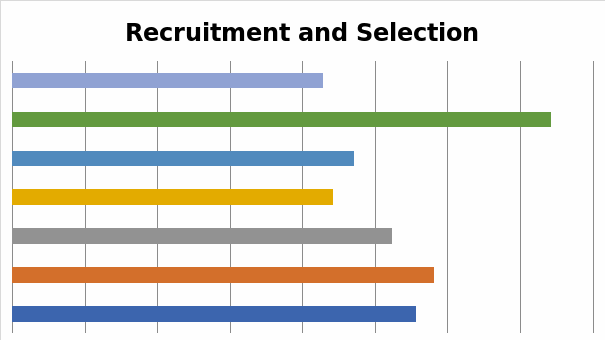
Approach to Diversity
The second element of HRM at Q-Tel that has been addressed in this research is the employer’s approach to diversity. Companies need to give due consideration to diverse ethnic, cultural, professional and religious backgrounds that employees may hold for ensuring employee motivation and job satisfaction. The results from the primary research conducted for this study suggest that employees working for Q-Tel disagree that HR policies and procedures pertaining to performance appraisal are in fact fair in regards to gender, color, and religion etc and they are actually contributing to conditions where ethnic values are well respected. The average values for both question and the statement are between 2 and 3 that imply that respondents are mostly disagreeing with these. On a statement related to employer’s consideration for various religious events that employees may be engaged in from time to time the collected responses imply a neutral response as the average value of these responses is just above 3. This suggests that respondents are not sure whether or not the company is considerate to allow time off from work to attend such events.
Table 3: Approach to Diversity
The above findings based on Likert scale model are depicted in the following figure while percentage of responses for each statement and question are attached as Appendix III.

Promotion and Rewards
Perhaps the most important factor that contributes towards employee motivation and job satisfaction is the monetary reward or compensation they received for their efforts for their employers. This area of research therefore required more questions to be inquired from the employees of Q-Tel. Since one of the limitations of the survey questionnaire is that it didn’t include any question that could differentiate between respondents on the basis of their job position and status therefore the results for the question related with payment for overtime work by the employer are excluded from this discussion as collected responses for this question are not sufficient to draw any important findings.
The questions and statements included under this category were aimed at evaluation of how the company’ HR department perform job appraisals and provide employees opportunities to realize their personal goals and objectives. The collected responses underline perceptions of employees regarding HR policies on promotion and rewards.
Employees of Q-Tel agree that possibilities of promotion and sufficient training offered by the employer can actually contribute to their motivation as average score of these questions is between 3 and 4. However, respondents’ view of HR policies and procedures related to different aspects of promotion and rewards are disappointing. Majority of the respondents disagree that they receive regular feedback on their performance from HR dept or their immediate supervisor and they receive fair chance for promotion, increment and other benefits from their employer. The question aiming at assessing the role of HR is resolving issues regarding employee’s concerns over their monetary returns resulted in responses suggesting that majority of respondents are disagreeing that HR department actually helps them out to resolve their issues. Realization of self-respect needs and personal career goals are essential for employees to stay in a particular job. A specific mind frame is developed by employees with respect to the working conditions and opportunities they may receive. These could help them attain a feeling of job satisfaction. Findings from the survey questionnaire imply that majority of respondents disagree to the fact that their employer and its policies are helping them with personal attainments as the average score of responses is less than three.
Another area of investigation is training. Respondents are of the opinion that Q-Tel does not offer sufficient training to employees on a regular basis. This is reflected from a very low average score of only 2.29 to the question inquired from respondents. Finally, the last statement under the category implies that respondents are of the opinion that gender biasness does exist in HR policies and procedures regarding promotion and rewards.
Table 4: Promotion and Rewards
The findings from the primary research are depicted in the following figure. However, the percentages of all responses are graphically presented as Appendix IV.
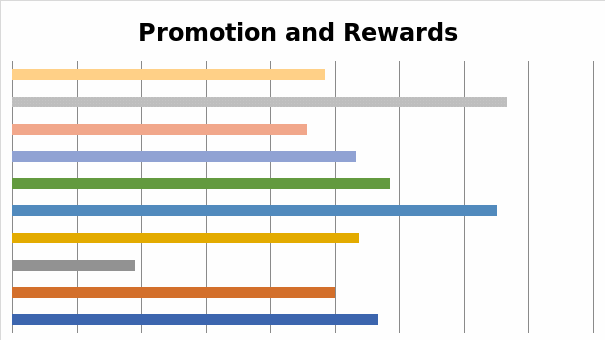
Retention
The element of HRM related to retention of employees is primarily driven from the level of motivation and job satisfaction that employees can attain while staying with their present employer in a specific job position. Employers must realize the intellectual value their employees hold and know the circumstances they have to face if their employees move to their competitors. Averages of responses collected from the primary research suggest that employees view negatively the company’s policies and procedures for them to feel part of the corporate team and be responsible for their decisions and innovative actions. Majority of respondents disagree that they are actually progressing with the company. Moreover, respondents disagree that the working conditions within the organization are good enough to instigate feelings of motivation and job satisfaction.
Table 5: Retention
These findings are also graphical presented in the following figure and the percentages of responses collected under this category are also included in Appendix V.
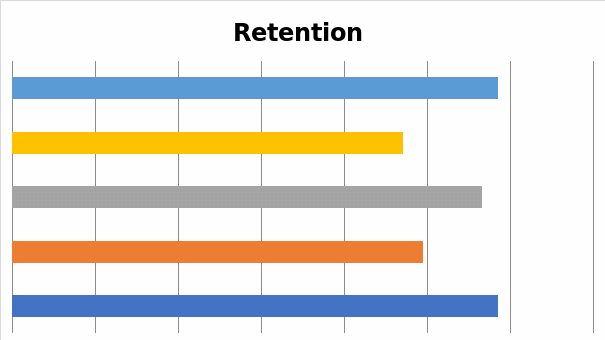
Overall Assessment
The reason for presenting views of respondents on their overall assessment separately is to assist in deriving important conclusions from the study. The following table clearly suggests that employees overall assessment of the recruitment and selection process of Q-Tel and its promotion and reward policies are poor. The averages of responses for both elements of HRM remain less than three that implies that majority of employees are dissatisfied with the way these issues are dealt with by their employer. On the other hand responses collected from employees through the primary research in relation to the company’s approach to diversity and retention of employees suggest that majority of respondents are satisfied with HR policies and procedures as the average score based on Likert scale is more than three.
The overall employee satisfaction related to the HR policies and procedures remains at a reasonable level of satisfaction reflected by the average score of 3.19. The percentage scores are included in Appendix VI.
Table 6: Overall Assessment
Analysis
The analysis of the secondary sources extending over the corporate literature obtained from the company suggests that the company has well documented HR manual that provides details of policies and procedures. The company invests in heavily in a process referred to as ‘Qatarisation’ that is aimed at providing greater job, internship and scholarship opportunities to local graduates. However, the company gives training to those non-residents who posses high educational achievements. The company also differentiates between Qatari and non-Qatari employees for furniture benefits. They are also offered pension plans that are not available to expatriates. Although the company has set out its program for employees’ promotion guidelines however it does not highlight performance appraisal methods. Furthermore, priority is given to Qatari nationals for promotion prospects than expatriates (Q-Tel 2008). On the other hand its guidelines for rewards are clearly set out which outlines different possible rewards to be granted to employees. There are also opportunities for employees to received CEO Excellence Award upon displaying extraordinary achievement. Decisions for promotion are approved by CEO or HR Committee but it does not highlight any procedures for dealing with employees’ concerns.
The company employs effective methods for communication but this does not indicate the frequency and participation of employees in such meetings. However, online communication seems effectively implemented. The company has also laid out payment for overtime by employees however this is restricted to certain number of hours per week but does not refer to situations where employees may have to work more than the prescribed number of hours. The company has incorporated number of days off for special Islamic events however no disclosure is made regarding religious events of other religions (Q-Tel 2008).
Recruitment involves HR Talent Sourcing and final decision is made by the Business Unit before approval from the HR committee and issuance of confirmed employment or rejection. Stage wise recruitment process is very clearly set out in the company’s policy manual. However, it doe refer to Qatarisation plan of the company but does not fully expand on how the company aims to implement it (Q-Tel 2008). The company has held a strong position in regards to HR activities in the present financial crisis. Instead of carrying out any redundancy programs the company has added 100 more head counts to its current work force.
The findings from the present study are very crucial as the company aims to promote high employee involvement and strategic placement of its HR policies and procedures that could actually promote higher employee motivation and job satisfaction. The company aims to steer up employees’ engagement that is viewed by the company as “the state of emotional and intellectual involvement that motivates employees to do their best work” (Q-Tel 2010). The findings from the survey questionnaire suggest some of the matching results that have been presented by the company in its latest employee survey. This survey suggested relatively lower scores for satisfaction based upon employees’ perception of the opportunities they have for career development, promotion, and recognition. Promotion seems to be the most challenging task for the company to ensure that the deserving individuals receive it (Q-Tel 2010), it is also clear from the present study that employees disagree with the company’s HR policies and procedures that is resulting in lower level of employee satisfaction. The results from the present study also suggest lower levels of support from the supervisors and their recognition of employees’ efforts that are also reflected in the survey conducted by the company (Q-Tel 2010).
Elaboration of Research Questions
This section of the chapter aims to provide reasonable answers based on the above findings and analysis in order to reach important conclusions regarding the efficiency and effectiveness of HR policies and procedures presently practiced by the company under review that is Q-Tel.
Summary
From the findings of survey questionnaire and analysis of the results along with the examination of corporate sources it is clear that the company has followed internationally accepted ways of underlining its detailed HR policy and guidelines however employees working in the company do not view these to be contributing to their personal career goals and development. They are of the opinion that these policies are somewhat biased towards the new motion of Qatarisation that limits their ability to realize their objectives and display their working capabilities in a better way.
Conclusions and Recommendations
The research based on a case study of Qatar Telecom has investigated various elements of HRM. These elements under review included recruitment and selection, approach to diversity, promotion and reward, and retention. All four elements of HRM has been addressed in this research by present important literature review encapsulating different theories, hypotheses and concepts of motivation and job satisfaction. Furthermore, reference to previous researches provides useful basis for understanding the need for employees’ satisfaction for ensuring the success of the business. Monetary returns, rewards and benefits seemed to be the most appreciated element of HRM by employees that is most sought after. In addition to the monetary aspect of a job other factors such as diversity, working conditions, ability to innovate and take decisions, recognition of work and work life balance (Maslow’s Hierarchy of Needs, Herzberg’s Motivation-Hygiene Theory, Skinner’s Reinforcement Theory of Motivation; Locke’s Goal-Setting Theory of Motivation) also play an important role in motivating employees and deriving them on the course to contribute to the success of the business.
The present study specifically takes into account Maslow’s Hierarchy Model (1943) for identifying various factors that influence human behavior and generate specific responses to particular working conditions. The primary research encompassing survey questionnaire was developed by keeping these factors in view and devising questions and statements that were aimed at formulating an overall opinion on how HR policies and procedures contribute to employees’ motivation and satisfaction.
Employees’ response to fulfillment of self needs and self actualization has shown a poor perception of the company’s policies and procedures. The present study revealed that employees do not consider the HR policies to be fair and equal regardless of gender, culture, social, and religious background. Although the company promotes respect for different religious beliefs but its policies do not provide any reference to holidays that may be requested by individuals belonging to religions other than Islam. Majority of respondents are not satisfied with the promotion and rewards policies of the company. These could have damaging impact on the motivation level of employees and their commitment to work. Companies operating in Qatar are promoting their national interests by embarking on a process referred to as Qatarisation. As a result of this move priority is given to local nationals at all stages of employment. This creates a sense of disparity amongst non-residents who may be working for the company for a longer period or may hold better qualification or experience. The company held a strong position during the recent financial crisis and it did not undergo any redundancy program that could be viewed a positive sign from employees’ perspective as the company retained its entire staff despite of difficulties in business. The findings presented in the report therefore imply that poor perception of HR policies and procedures by employees leads to lower level of motivation and thus reduces the level of satisfaction. Thus, there is a negative relationship between low level of motivation and job satisfaction as suggested by Koh and Goh (1995).
The results from the primary research are very similar to those presented in a survey conducted by the company itself. Similar results have been highlighted by the company itself regarding employee satisfaction that adds to the validity of the outcome of the present study.
Hypothesis Testing
From the findings of primary research and subsequent analysis of these findings with reference to secondary sources suggest the following outcome for testing the validity of two research hypotheses set out for the present study.
- the HRM policies and practices implemented by Q-Tel are positively contributing to employees’ performance, motivation and satisfaction.
This hypothesis is tested out in this report through analysing employees’ responses collected via survey questionnaire to different elements of HRM implemented by Qatar Telecom. Four different elements of HRM including recruitment and selection, approach to diversity, promotion and rewards, and retention were examined for the sufficiency, efficiency and effectiveness of HR policies and procedures. The overall satisfaction level of employees is at moderate level. However, upon evaluating responses to different questions and statements under each category of elements the research concluded that majority of respondents disagree with that recruitment and selection process and promotion and reward policies of HR contribute positively to employee motivation and job satisfaction. While on the other hand majority of respondents neither agree nor disagree that the company’s approach to diversity and retention policies contribute positively to employee motivation and job satisfaction.
- the HRM policies and practices implemented by Q-Tel are not comparable to the global standards and are negatively contributing to employees’ performance, motivation and satisfaction.
This hypothesis is tested out by evaluating the responses of employees working in the organization along with the information collected from the corporate literature. The company seems to have well documented HR policies and guidelines. All various elements of HRM have been addressed sufficiently by the company. However, the issue of Qatarisation is surely affecting employees’ view of the fairness of the company’s HR policies and procedures. In particular local residents are given priority over expats for recruitment, promotion and rewards that generates poor sentiments and negativity amongst employees. The responses collected from the primary research support this fact as majority of employees view HR policies negatively that are related to recruitment and selection and promotion and reward.
From the above it can be concluded that Qatar Telecom although following global standards for managing its human resource capital however there are certain weaknesses in its implementation that needs to addressed by considering the following recommendations provided by the researcher.
Recommendations
Both content and process theories suggest that human behaviour is driven by various factors such as pay, promotion, benefits, security, recognition, and working conditions. Companies need to find a right balance between all these factors to ensure that employees working for them remain happy and satisfied with their current job positions. The following recommendations are set forward in response to the negative feedback by majority of respondents working for Qatar Telecom.
- Recognition and appreciation of efforts by employees is essential for keeping employees motivation. It is suggested that line managers should be provided greater support and guidelines to assist them in recognising good performance and holding conversations on career and development opportunities.
- Qatarisation although is being followed in the national interest however it is generating a lack of confidence and trust amongst employees working in companies based in Qatar. Priorities are set by companies to promote greater employment amongst local residents however this restricts company’s ability to seek talent externally. The company must set out some definite guidelines for giving equal opportunities to all individuals on the basis of their performance rather than their background.
- In view of Qatarisation process it is suggested that frequent communication is made regarding human policies and promotion pertaining to promotion and rewards. If there are any changes in appraisal methods and management decisions they should be communicated well to employees to ensure that they perceive these as equitable.
- The company must develop ways of opening up access for employees to the human resource department. At present most of the decisions are either made by the human resource committee or the company’s CEO. This is one of the reasons that employees may consider incapability of the HR department to address their issues and problems as identified in this study.
- The HR department must align intrinsic factors so that employees can have the confidence that they will receive similar benefits if they work for another employer.
- The company must adopt real time performance appraisal system that would ensure that all employees have equal opportunity to get their work recognised by the HR committee. There must be standardized reporting on a regular basis so that employees performance can be evaluated without any disparities.
- The company must publicize its recruitment and selection process on a fair basis so that individuals can expect equal opportunities regarding of race, gender, religion, disability etc.
Suggestions for Future Study
The recommendation for future research could be made after considering the limitations of the present study. The future study could be carried out by increasing the sample size and by differentiating the work force on the basis of job position and gender. Further information regarding salary levels and increments could be used to prepare the research from a perspective of evaluating the impact of monetary returns on motivation and job satisfaction. Although qualitative research is considered suitable for this type of study another approach could be suggested that uses quantitative approach to estimate correlation between various extrinsic and intrinsic factors of motivation and job satisfaction. This would involve the use of regression model to conduct a multivariate analysis of the impact of these motivation factors on job satisfaction. Finally, a future research can be conducted that provides a comparison of Qatar Telecom with another major telecommunication company such as Etisilat operating in the UAE. This research could provide greater insight into the differences between employees’ perceptions working for both companies that are serving similar markets and promote similar nationalisation interests.
Self Reflection
Introduction
For a researcher self reflection is a way of providing his account of the learning process throughout the process of conducting a research encapsulating his personal beliefs, experiences, and learning styles that have helped him in achieving the objectives of the research. This allows him to identify his strengths and weaknesses that could help in applying his experience in a work place later on in his professional life (Gill and Halim 2006).
Choosing and formulating the Research topic
The initial step of choosing a research topic for the study was based on the researcher’s intuition of a particular subject area of employee motivation and job satisfaction in HRM. His keen interest in carrying out a study that would identify and assess different extrinsic and intrinsic motivation factors that could help employees achieve job satisfaction led him to choose the research title. The researcher has a strong connection with Qatar Telecom and he has a good understanding of the HRM issues facing companies operating in Qatar. Due to the lack of previous researches that have specifically focused on telecom industry in Qatar he decided to carry out this particular study that would be valuable for Qatar Telecom. This study would help the company to understand the extent of the problems it is facing in acquiring and retaining valuable human capital. The learning of HRM has given a new insight into human behaviour that could be very useful and extended to other companies in Qatar.
Critically reviewing the literature
Gathering vital information to formulate the literature review for the research was not an easy task. In order to satisfy the objectives of the research it was necessary to do ample amount of reading of various secondary sources that are available in the form of books, journals, articles, web pages etc. to be sure that the literature review includes all important theories and concepts of motivation and job satisfaction. Understanding different theories that have been proposed over the last few decades helped the researcher to draw basis for conducting the present research. In particular Maslow Hierarchy model though considered to be the most simplistic models does in fact lay out path for future studies like the one carried out in this report. Critical review of different theories helped the researcher to understand that not a single theory explains all factors contributing to employees’ motivation and job satisfaction. Therefore, extensive study of these concepts was required that would surely provide an edge if the researcher gets an opportunity to apply them in a work place.
Designing the method of Research
The researcher clearly understands that the deciding upon the most suitable research methodology is crucial for achieving the desired outcome from the study (Polkinghorne 2005). For this purpose different methodologies were evaluated for their application and upon critical reviewing of various possible approaches the present study was based on a qualitative approach to serve the purpose of the study in an objective manner. The use of both primary and secondary sources was considered vital to provide a comprehensive comparative analysis. The results from the primary research are supported by evidence collected from the secondary sources that makes it much more reliable study. The decision to make use of Likert scale model for summarizing the findings was based on the experience of the researcher with this technique and its simplicity allowing respondents to make selection for a possible five responses (Trochim 2006). The choice of survey questionnaire was made once other primary data collection techniques were considered for their limitations and difficulties to implement as the principal company is based in another country and there were barriers of distance, cost and time that the researcher had to balance.
Designing questionnaire
Designing questionnaire was the most difficult step towards achieving the purpose of the primary research. The researcher was able to draw guidelines was developing the questionnaire on the basis of his understanding of different motivation theories and concepts. The entire questionnaire was divided into four elements of research that have been set out for this study and are considered to be important elements of HRM. The overall design of the questionnaire was made to keep it simple and avoid any such question that could reveal the identity of the participants. This was considered important by the researcher so that responses that are not biased can be achieved. It was also ensured that all four elements of HRM are fully covered by including larger number of questions and statements under each category.
Data analysis
Since qualitative approach was selected for this research therefore it was necessary for the researcher to avoid subjectivity of interpretation of findings from the primary research. Due consideration was given and various literature was thoroughly examined to ensure that the findings are presented in the best possible manner using Likert scale model. For analysis important information was requested from the company under review which was evaluated and incorporated to provide a descriptive comparison of current findings with previous corporate literature.
Writing a report
Achieving conformity between different sections of the report was crucial therefore step by step completion was made by the researcher. Organizing various sections of each chapter ensured that the work flow is simple and for better understanding of the users of this report. Language has been kept professional and all the report was proof read to avoid any typing errors and grammatical mistakes ensuring the report meets the standards of MBA report submission.
Conclusion
Finally, it could be stated the entire learning process is cognitive in nature (Zimmerman and Schunk 2001) that is based on learning made throughout MBA program. The present study has helped the researcher not only to learn theories and concepts in HRM but also assisted him in developing communication, brain storming, analytical, time management and writing skills. The researcher has learnt an important lesson to carry out a professional research and this experience would surely him to become a valuable asset for the company that he may pursue his career with.
References
Ali, A. J., 1990. Management theory in a transitional society: The Arab’s experience. International Studies of Management and Organisation, pp.7-35.
AME Info, 2010. Qatar Telecom. Web.
Billingsley, B. S. and Cross, L. H., 1992. Predictors of commitment, job satisfaction, and intent to stay in teaching: A comparison of general and special 127 educators. Journal of Special Education, 25(4), pp.453-72.
Bloomberg, 2010. Qatar Telecom (QTel) Q.S.C.. Web.
Brayfield, A. H. and Rothe, H. F., 1951. An index to job satisfaction. Journal of Applied Psychology, 35(5), pp.307-11.
Carsten, J. M. and Spector, P. E., 1987. Unemployment, job satisfaction, and employee turnover: A meta-analytic test of the Muchinsky model. Journal of Applied Psychology, 72, pp.374-81.
Chew, Y. T., 2005. Achieving Organisational Prosperity through Employee Motivation and Retention: A Comparative Study of Strategic HRM Practices in Malaysian Institutions. Research and Practice in Human Resource Management, 13(2), pp.87-104.
Cotton, J. L. and Tuttle, J. M., 1986. Employee Turnover: A Meta-Analysis and Review with Implications for Research. Academy of Management Review, 11(1), pp.55-70.
DeVaney, S. A. and Chen, Z. S., 2003. Job Satisfaction of recent graduates in Financial services, US Department of Labour. Bureau of Labour Statistics, Compensation and Working Conditions.Web.
Dubin, R., 1958. The World of Work. Englewood Cliffs, NJ: Prentice Hall Inc.
Gill, G. K. and Halim, N. A., 2006. Reflection in action: Examining the place, impact and management issues surrounding the integration fo reflection in classroom practice. In AARE 2006 Conference. Adelaide.
Hackman, R. and Oldham, G. R., 1976. Motivation through design of work. Organizational behaviour and human performance, 16, pp.250-79.
Heilmann, 2008. Effects of Career Plateauing On Turnover: A Test Of A Model. Journal of Leadership & Organizational Studies. , 15(1), pp. 59-68.
Hertzberg, F., Maunser, B. and Snyderman, B., 1959. Motivational Theory. New York: Wiley.
Herzberg, F., Mausner, B., Peterson, R. O. and Capwell, D. F., 1957. Job Attitudes: Review of Research and Opinion. Psychological Service of Pittsburgh.
Hubbard, E. E., 2004. The diversity scorecard: evaluating the impact of diversity on organizational performance. New York: Butterworth-Heinemann.
Jackson, S. E., 1992. Diversity in the workplace: human resources initiatives. New Jersey: Guilford Press.
Jerald, R. A. B., 2000. Behavior in Organization. New Jersey: Prentice Hall.
Jerald, Robert A. Baran. Behavior in Organization. New Jersey: Prentice Hall, 2000.
Key, J. P., 1997. Qualitative Research. Web.
Koh, H. C. and Goh, C. T., 1995. An analysis of the factors affecting the turnover intention of non managerial clerical staff: A Singapore study. The International Journal of Human Resource Management, 6(1).
Koys, D. J., 2001. The effects of employee satisfaction, organizational citizenship behavior, and turnover. Personnel Psychology.
Krau, E., 1981. Turnover analysis and prediction from a career developmental point of view. Personnel Psychology, 34(60), pp.771-90.
Kumar, S. A., 2008. Entrepreneurship Development. New Delhi, India: New Age International.
Lakhani, H., 1988. The Effect of Pay and Retention Bonuses on Quit Rates in the US Army. Industrial & Labor Relations Review, 41, pp.430-438.
Lambert, E. G., Hogan, N. L. and Barton, S. M., 2001. The impact of job satisfaction on turnover intent: A test of a structural measurement model using a national sample of workers. Social Science Journal, 38(2), pp.233-51.
Malhotra, N. K., 2009. Marketing Research: An Applied Orientation. New Dehli: Pearson Education India.
Meyer, J. P. and Allen, N. J., 1997. Commitment in the Workplace, Theory, Research and Application. Thousand Oaks, CA.: Sage Publications.
Michaels, C. E. and Spector, P. E., 1982. Causes of employee turnover: A test of the Mobley, Griffeth, Hand, and Meglino model. Journal of Applied Psychology, 67, pp.53-59.
Miller, J., 1980. Individual and Occupational Determinants of Job Satisfaction. Work and Occupations, pp.337-66.
Muna, F., 1980. The Arab executive. New York: St. Martin’s Press.
Pintrich, P. R. and Schunk, D. H., 2002. Motivation in education: Theory, research, and. Columbus, OH: Merrill.
Polkinghorne, D. E., 2005. Language and Meaning: Data Collection in Qualitative Research. Journal of Counseling Psychology, 52(2), pp.137-45.
Porter, L. W. and Steers, R. M., 1973. Organizational, work and personal factors in employee turnover and absenteeism. Psychological Bulletin, 80(2), pp.151-76.
Porter, L. W., Bigley, G. and Steers, R. M., 2002. Motivation and Work Behavior. 7th ed. New York: McGraw-Hill/Irwin.
Q-Tel, 2008. HR Guideline for Promotion. Policy Manual. Doha, Qatar: Q-Tel.
Q-Tel, 2008. Human Resource Policy Manual Version 2.0. Intranet version. Doha, Qatar: Q-Tel.
Q-Tel, 2008. Human resource Procedure Recruitment Version 2.0. Policy Manual. Doha, Qatar: Q-Tel.
Q-Tel, 2010. Qatar Telecom 2010 Engagement Survey. Executive Team Results Presentation. Doha, Qatar: Q-Tel.
Saunders et al, M., 2007. Research Methods for Business Students. Essex: Pearson Education.
Skehan, P., 1989. Individual Differences in Second Language Learning.. London: Edward Arnold.
Skinner, B. F., 1953. Science and Human Behavior.. New York: Macmillan.
Sousa-Poza, 2000. Well-being at Work A Cross- National Analysis of the Levels and Determinants of Job Satisfaction. J. Socio-Economic., 12, pp.517-538.
Taylor, B., Gautam, A. and Ghoshal, T., 2006. Research Methodology: A Guide for Researchers in Management and Social Sciences. Delhi: PHI Learning Pvt. Ltd.
Test, D.W., Flowers, C., Hewitt, A. and Solow, J., 2003. Statewide study of the direct support staff workforce. Mental Retardation, 41(4), pp.276-85.
Thorndike, E. L., 1911. Animal Intelligence: Experimental Studies. New York: Macmillan.
Ting, Y., 1997. Determinants of job satisfaction of federal government employees. Public Personnel Management, 26(3), pp.313-335.
Trochim, W.M., 2006. Likert Scaling: Research Methods Knowledge Base. Web.
Tutuncu, O. and Kozak, M., 2006. An investigation of factors affecting job satisfaction. Int. J of Hospitality and Tourism Admin, 8(1), pp.1-19.
Vroom, V. H., 1964. Work and Motivation. New York: John Wiley & Sons.
Weisberg, J. & Kirschenbaum, A., 1993. Gender and turnover: a re-examination of the impact of sex on intent and actual job changes. Human Relations, 46, pp.987-1006.
Weiss, H. M., 2002. Deconstructing job satisfaction: separating evaluations, beliefs and affective experiences. Human Resource Management Review, 12(173-194), p.174.
Weiss, H. M., 2002. Organizational behavior: affect in the workplace. Annual Review of Psychology, 53(279-307), p.282.
Zaphiris, P. and Ang, C. S., 2009. Human Computer Interaction: Concepts, Methodologies, Tools, and Applications. Hershey, PA : Idea Group Inc (IGI).
Zimmerman, B. J. and Schunk, D. H., 2001. Self-regulated learning and academic achievement: theoretical perspectives. New York: Routledge.
Zimmerman, R. D., 2008. Understanding the Impact of Personality Traits on Individuals’ Turnover Decisions. Personnel Psychology.
Appendix I: Survey Questionnaire
Dear Respondent,
The current survey is requested as a part of my MBA dissertation tilted “Analysis of effectiveness and efficiency of HRM policies – A case of Qatar Telecommunication Company (Q-Tel)”.
The survey questionnaire is carefully designed to cover different aspects of human resource policies and procedures in your company to assess its sufficiency, efficiency and fairness in regards to different elements of HRM such as recruitment and selection, approach to diversity, promotion and rewards and retention of employees.
Researcher hereby undertakes that no information provided by the respondent will be used for any purpose other than academic. If you wish to withdraw your responses at any time prior to the write up of the research report you can do so by informing the researcher. No information collected through this survey will be disclosed to any third party.
If you wish to inquire any further about the survey please do not hesitate to contact the researcher. Their contact details are provided as follows:
- Researcher: NAME OF THE STUDENT / CONTACT DETAILS.
Thank you for time, effort and support.
Appendix II: Recruitment and Selection
Is your company’s selection process fair regardless of gender, color, religion etc?
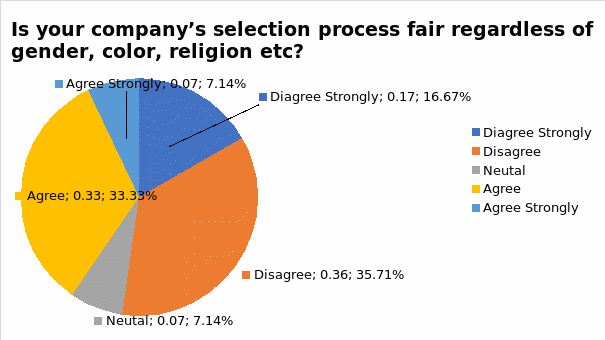
Does the recruitment centre follow professional standards?

Does your company offer equal opportunities to both men and women?
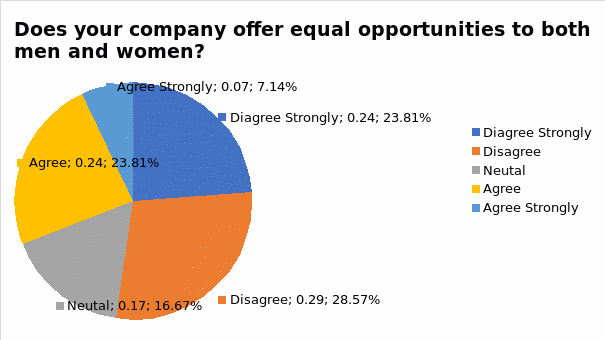
Does your company offer equal opportunities to both expatriates and non-expatriates (local)?
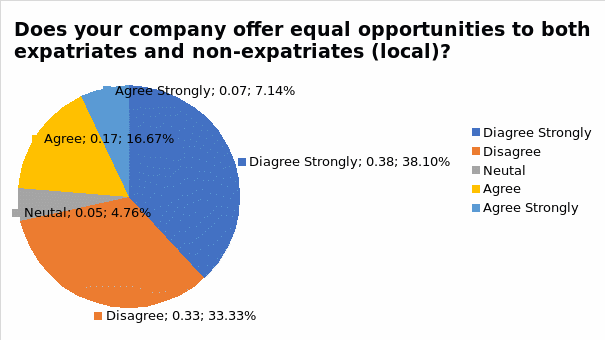
Is your compensation level comparable to the industry standards?
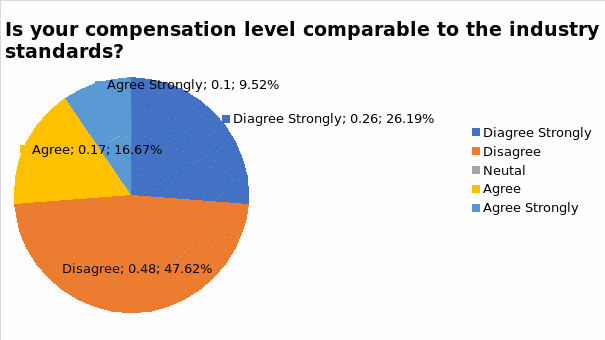
Does HR department provide you with the company’s code of conduct at the time of recruitment?
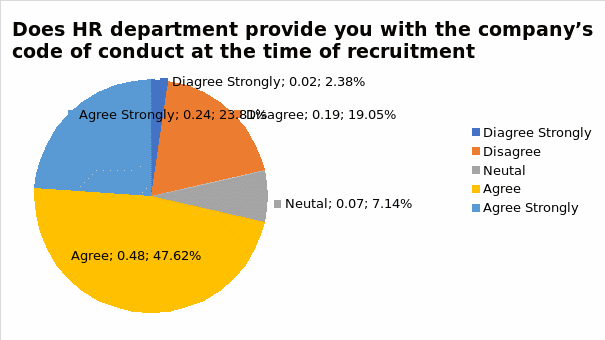
Does your company implements effective employee feedback system regarding recruitment process?
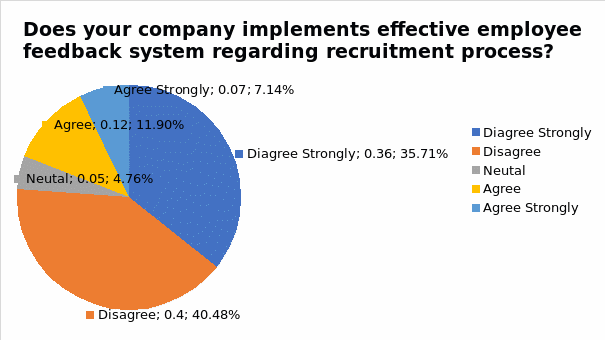
Overall assessment of the recruitment and selection process of your company:
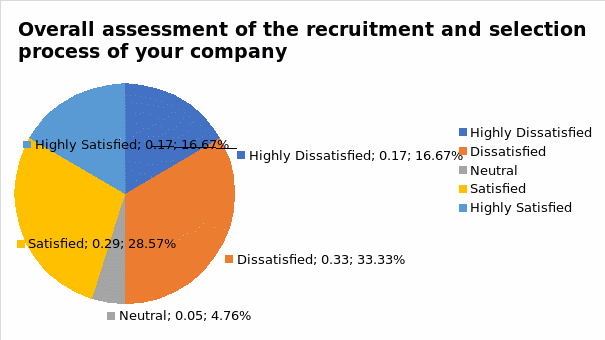
Appendix III: Approach to Diversity
Your company’s appraisal process fair regardless of gender, color, religion etc?
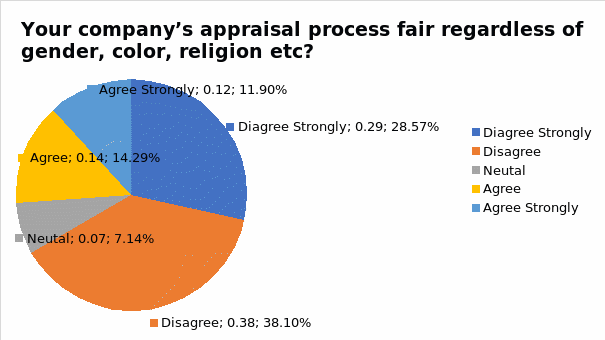
Differing ethnic values are respected in the company:
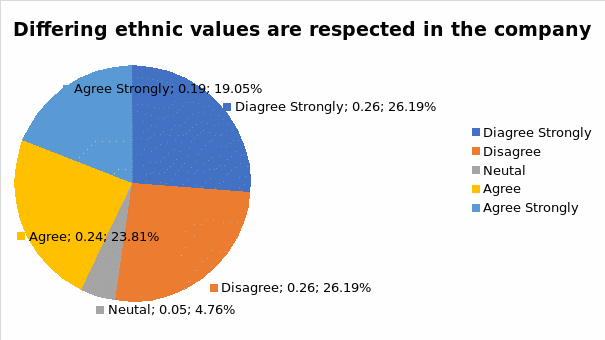
Employees are given consideration on respective religious events:
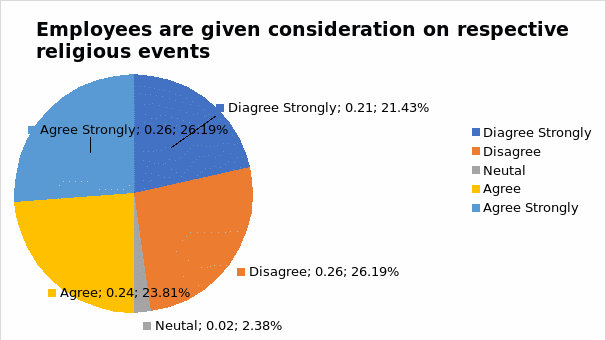
How do you feel about your company’s approach to diversity?

Appendix IV: Promotion and Rewards
Do you receive regular feedback on your performance from HR dept or your immediate supervisor?

Do you think that HR policies for promotion, increment and other benefits are fair?
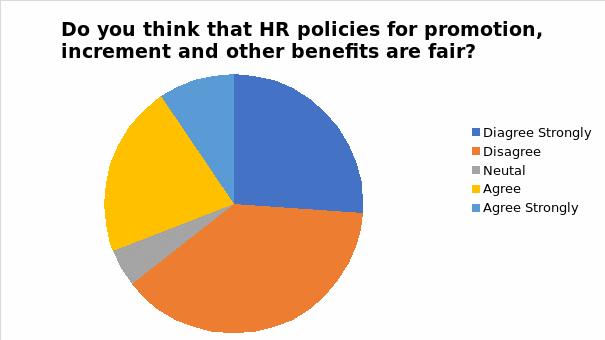
Do you get paid for overtime by your employer? (If applicable)
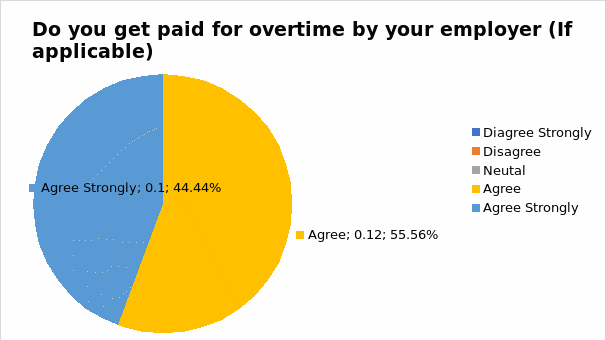
Does HR dept assist you in resolving issues regarding your monetary concerns?
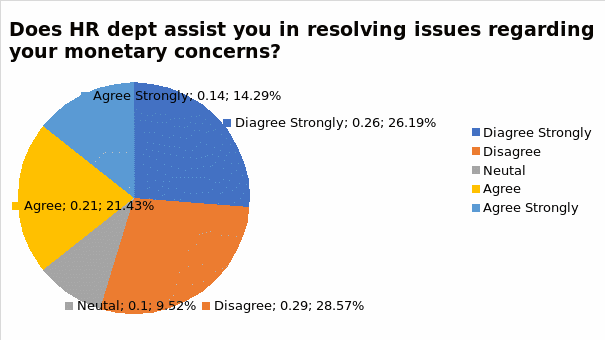
Does the prospect of a promotion motivate you?

Your company contributes towards your self-respect needs?
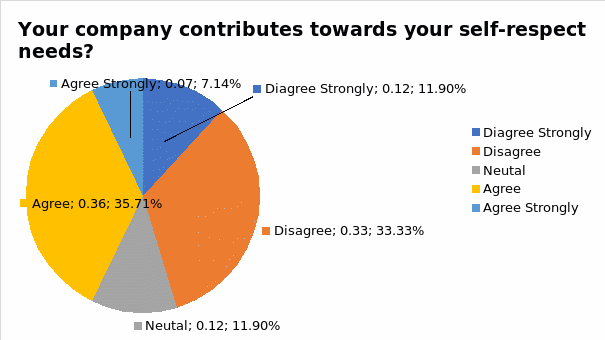
Your company assists you in realizing your personal career goals?

Are you given sufficient training?
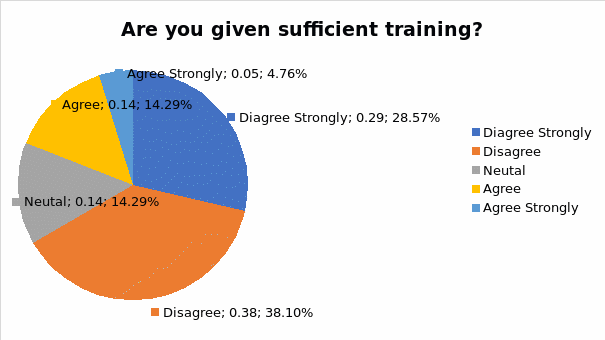
Do you believe that training can contribute to your development as an employee?

Rewards & Promotions are without any biasness to gender:
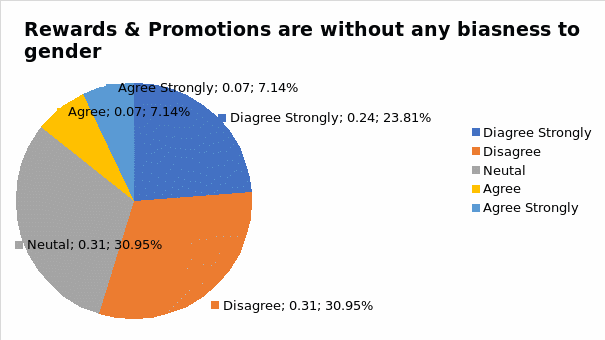
Overall assessment of the promotion and reward policies of your company:
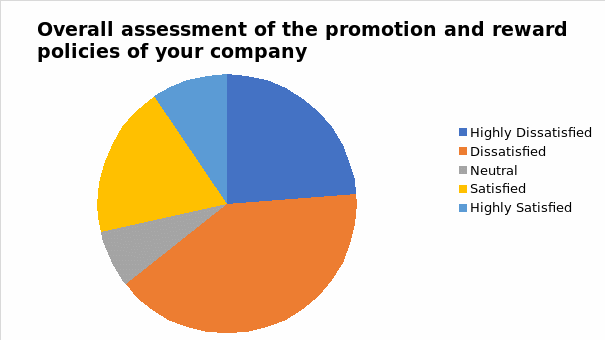
Appendix V: Retention
You feel part of the corporate team:
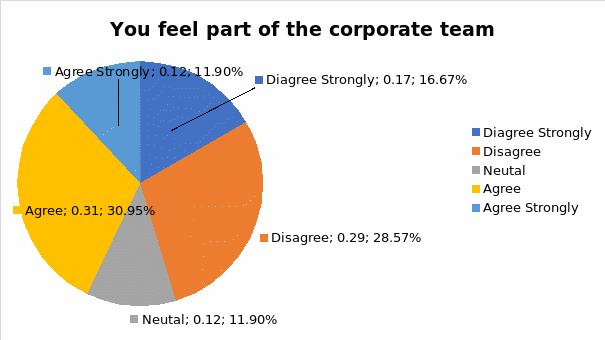
Your company allows you to be innovative:
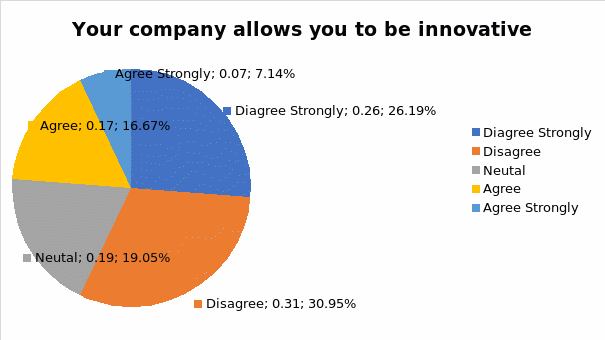
You are allowed to make decisions related to your work:
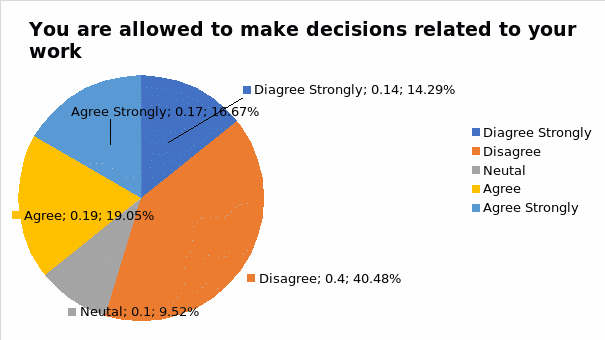
You are progressing within your company:
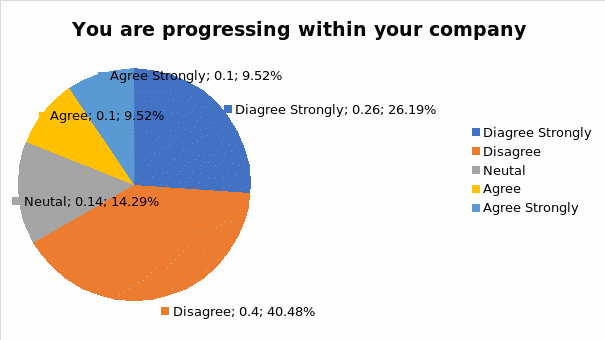
You company offers good working conditions:
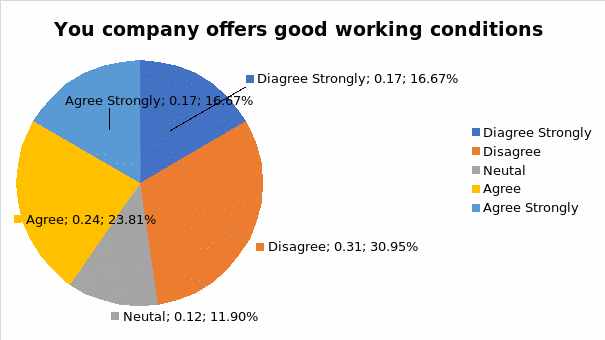
Overall assessment of the retention policies and procedures of your company:

Appendix VI: Employee Satisfaction
Overall employee satisfaction related to the HR policies and procedures of Q-Tel?
